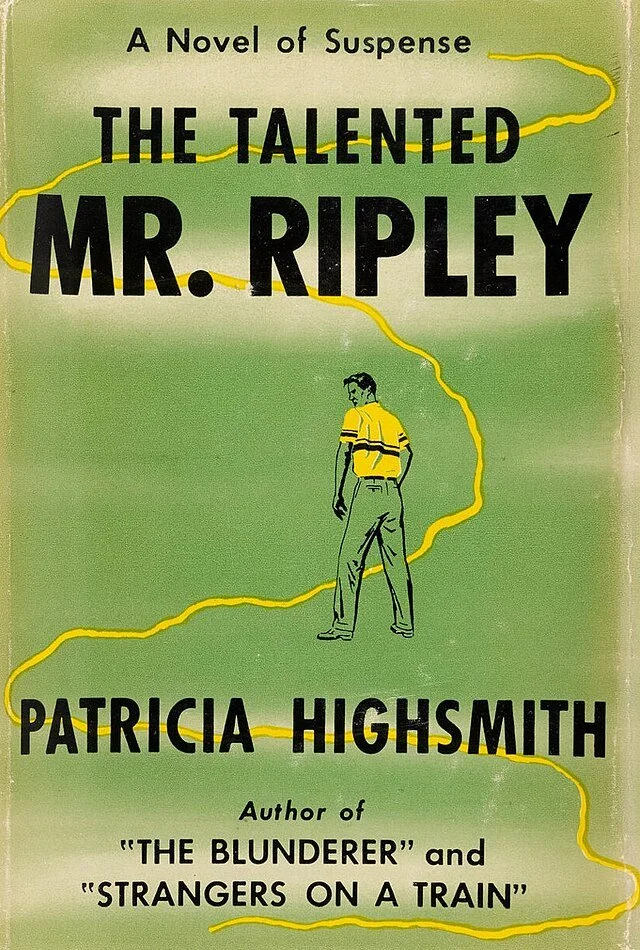Create, Flee, Forget: a Review of The Future Was Color by Patrick Nathan
In a 1981 interview with The Armchair Detective, Patricia Highsmith is asked whether the sensibility of an artist is close to the sensibility of a criminal. No, she responds, except in one particular area: like the criminal, the artist “has to forget about his own personal morals, especially if he is writing about criminals. He has to feel anything is possible.” Highsmith’s best-known criminal, first introduced in 1955’s The Talented Mr. Ripley, has become emblematic of the complex villain, the character for whom we can’t help but root despite his unforgivable crimes.
I thought of Ripley often while reading Patrick Nathan’s gorgeous, visceral novel The Future Was Color, out now in paperback from Counterpoint Press. It opens in 1956 Hollywood, where a screenwriter named George Curtis, a Jewish émigré from Hungary, extends a one-night stay with his glamorous actress friend Madeline into a residency that lasts more than a week. The residency transforms into a bender; the bender concludes, explosively, in a drug-filled Las Vegas hotel room. Over a string of hazy, erotic misadventures, George strives to recover his ambition to be an essayist, examines his feelings for and about the multiple handsome men with whom he consorts, watches from a distance as tragedy unfolds in his homeland, and parties quite hard.
Part 1 of the novel is named “Los Angeles.” “Las Vegas” is the title of Part 3. In between, the novel travels back in time and across the country to New York City, where George has landed after fleeing Budapest at the end of World War II and still goes by György Kertész. In New York, György falls in with a group of penniless artists and frequents “the toilets underneath Christopher Street…a long, busy stable of stall doors” where he discovers and then indulges in the pleasure of having sex with other men. Make no mistake: this is a book full of lust. Nathan presents his main character’s sexuality in raunchy, sometimes gleeful detail. It’s desire that eventually lands György in trouble, forcing him to flee New York. At the end of Part 2, he anglicizes his name in order to yet again escape persecution: like Ripley, he both finds and buries himself under different identities. Both a criminal—by the standards of his time—and an artist, György answers Highsmith’s call to forget: “In his imagination,” Nathan writes, “New York had been a city without a past.”
The novel doesn’t get to 1940s New York City, however, until it has spent 88 pages—more than a third of the book’s 209—in 1956 Los Angeles. This first section is intoxicating: debauched yet elegant, florid yet exquisite, fast-paced yet intricately detailed, relentlessly erotic. By the end of the first night of George’s residency, the boyish lover he brought to Madeline’s house has been claimed by her husband. George’s crush appears soon after—but is Jack Turner really who he claims to be? An idyllic, horny sailing trip blends into a chaotic, Dexedrine-fueled Halloween party. Sexual tension tightens, alcohol spills down throats, and George gets so caught up in his desire that he fails to divine Jack’s true reason for hanging around. Even once Jack’s ulterior motive is revealed, George can’t make his affection for his “favorite American” vanish; amid the wild partying, unrestrained lust, and disturbing news about the Hungarian revolution, his longing for Jack persists:
Always years, like the sepia silt that gathered on silver and tarnished your reflection. But one day, some poor country’s failed revolution came and polished time clean, and George saw, quite clearly, who his favorite American really was. Up until then, George said, it’d been so easy to believe he’d found a place to forget in—forever.
What gets forgotten, why, and who gets to decide are some of Nathan’s central concerns. His vivid prose imbues these questions with multiple strains of pain: the pain of losing parents and lovers, the pain of having one’s sexuality render him an outlaw, the pain of being a rootless Hungarian Jew. George writes earnestly about the tumult in Budapest—screenwriting is just something he does for income—but even this must be done in secret; he tells Madeline, “I’m putting some thoughts together, that’s all.” While the news about Hungary soon disappears from the front pages, its revolution “no longer stimulating to American readers,” it cannot fade from George’s heart or mind. In this endeavor he can succeed as neither artist nor criminal: he is forced to remember.
As is often the case with great novels, there are nearly infinite dimensions through which one can approach The Future Was Color. For a certain reader, its principal subject might be freedom—the freedom to love who one wants to love, screw who one wants to screw, write what one wants to write. Another might see it as a book about creativity; a third might interpret it as an exploration of sexuality. It is all of these things.
Yet it was indeed forgetting that I came to see as the principal subject of The Future Was Color. Forgetting, like Americans did about Hungary in 1956, as a privilege afforded some but not others. Forgetting as a desperate act of survival that George commits when he flees to LA, abandoning his New York friends, his entire New York identity. The ability of the American entertainment establishment to distract—to impose forgetting upon—the nation. The American medical establishment’s horrific use of forgetting as a cure, administered via electroshock therapy: its victim here is Paul, György’s first great American love interest, and he fades from György’s life slowly. After Paul leaves New York for a clinic that purports to treat what we would now call depression, he sends György mail that exposes his unraveling:
His letters, George told me—and I can attest, having seen them myself, in Paul’s script that transformed, over those weeks, from microscopic and contained to loose, jagged, uneven, to drifting up and over the lines on the paper like something seismic had changed—were decreasingly coherent and full of strange gaps. Events he remembered changed their settings; what had happened on Paul’s sofa was now György’s. A conversation at Yvette’s studio was now, as Paul told it, at the Waldorf. And these were the events Paul remembered at all.
One may wonder about the presence of an “I” in this passage. The book is framed as a series of memories relayed by George, decades later as he nears death, to an unnamed first person narrator: its structure seems to ask whether or not forgetting is truly possible.
This inclusion of the first person, however, is the rare decision of Nathan’s that begs questioning. Despite a few clues near story’s end as to the identity of this chronicler—he’s married to a man and seems to be living, roughly, in the present day (he’s experienced the pandemic)—I finished the novel feeling like he had somewhat intruded on the real story, George’s. The novel made me ask why it isn’t simply written in the third person, and I couldn’t find a satisfying answer. George’s trials are timeless enough, his aches human enough, that by drawing an explicit connection with our times Nathan comes dangerously close to cheapening his own efforts.
Likewise, while the first act carries all the urgency of falling in love—as with an infatuation, small, even mundane details take on extraordinary beauty—I somewhat lost my fervor as I read the second, third, and denouement sections. I came to see, though, that my experience mirrored the way lovers move into a steadier, more understated phase of a relationship, where expressions of affection are all the more meaningful for their subtlety. Readers more comfortable with a traditional narrative arc—such as the one found in a book like The Talented Mr. Ripley—could nonetheless be frustrated. Nathan is unafraid to take risks at both the structural and sentence level; his success rate with the latter is slightly higher.
Yet I’d rather read a great book than a perfect one. The risks taken by both Nathan and his protagonist ring true to the person each establishes himself to be. Unsuccessful gambles may have brought me even closer: in George’s case, to George; in Nathan’s case, to his tender triumph of a novel, which had wrapped me in its anxious arms from the very first line. “We want to burn, to be disintegrated,”The Future Was Color begins. It then proceeds to tell the story of a man atomized by the times in which he lives: made to flee, inspired, disintegrated, then transported someplace unforgettable.


